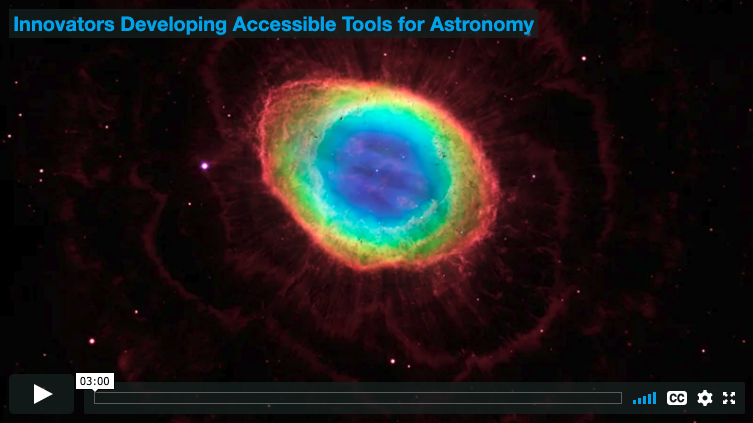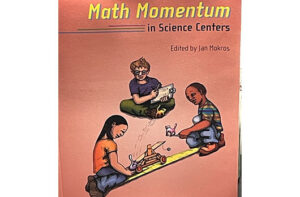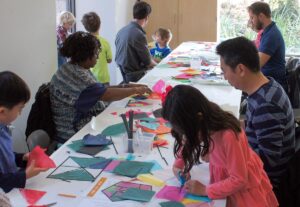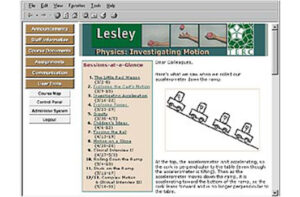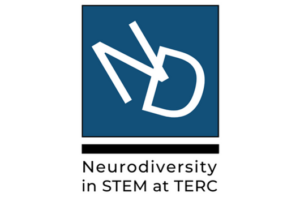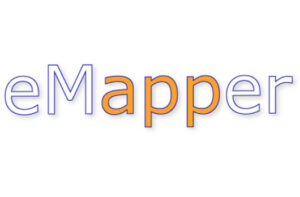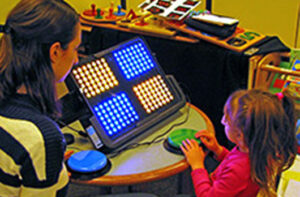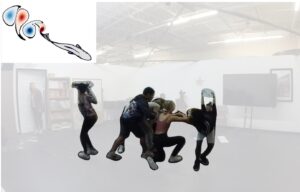Innovators Developing Accessible Tools for Astronomy (IDATA)
IDATA engages middle and high school students in designing software to make astronomy accessible to people with blindness or visual impairments.
Lead Staff:
Jim HammermanProject Staff:
Santiago GascaEric Hochberg
SummaryIf intelligent life without sight exists on some distant planet in our galaxy, these lifeforms would still explore the universe; how? This is a guiding question for Innovators Developing Accessible Tools for Astronomy (IDATA), a research initiative supported by the U.S. National Science Foundation – STEM + Computing Partnerships (STEM+C) Program.
Modern astronomy relies on computers and computational thinking for nearly every aspect of collecting, analyzing, and presenting data. Visual interfaces commonly used for these computational processes present unique challenges for blind and visually impaired (BVI) individuals. While BVI individuals are severely underrepresented across all fields of science, technology, engineering, and mathematics (STEM), the lack of vision-neutral tools in astronomy further increases the barrier-to-entry for BVI individuals.
The IDATA project, formally known as “Research Supporting Multisensory Engagement by Blind, Visually Impaired, and Sighted Students to Advance Integrated Learning of Astronomy and Computer Science,” is developing software to enable blind and visually impaired (BVI) students to engage in astronomy data collection and analysis using the Skynet Junior Scholars (SJS) portal to the Skynet remote telescope network. Groups of sighted and visually impaired middle and high school students work with project staff to engage in a user-centered design/ universal design (UCD/ UD) process to develop and test software modifications to increase accessibility of the site.
Students learn computational thinking (including elements of the Quorum programming language) and about the role of computation in scientific exploration, as well as astronomy content. SEEC’s research focuses on these learning goals, as well as student interest, sense of efficacy, science+computing identity, and their beliefs about who can do science and computing.
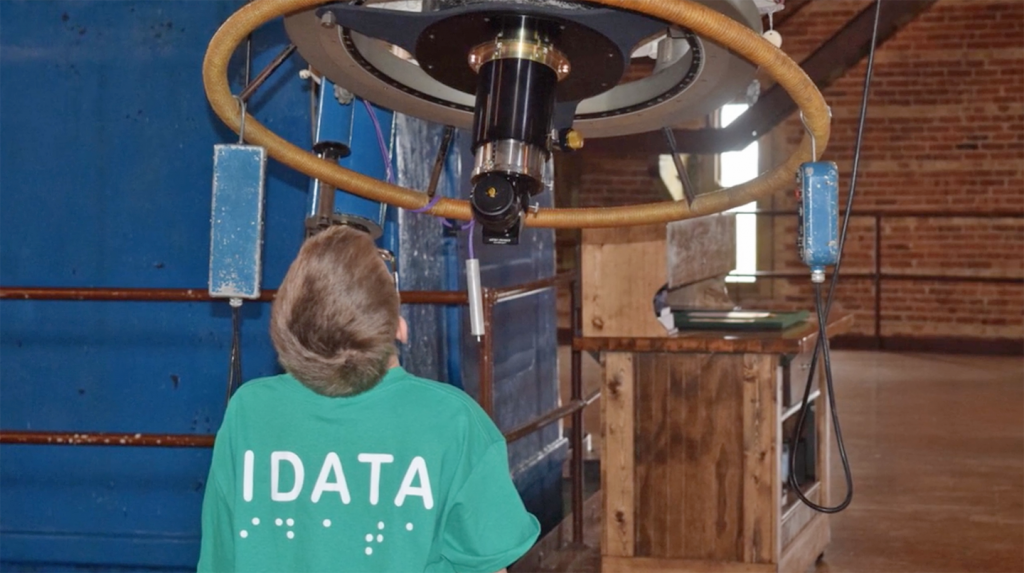
FindingsIDATA project investigators from Associated Universities Inc., Geneva Lake Astrophysics and STEAM (GLAS), Inc., TERC’s STEM Education Evaluation Center, University of Nevada Las Vegas, and Skynet at University of North Carolina at Chapel Hill, hypothesize that teaming up BVI and sighted students, teachers, and professionals in the design and development of astronomy software and instructional modules will result in more accessible tools for astronomy investigations, powerful educational experiences, and lower the barrier-to-entry for BVI (and all) individuals interested in astronomy and related careers.
VideosAfterglow Access SoftwareThe Afterglow Access (AgA) is a complete browser-based astronomy image and data analysis software tool. The software is designed to work with screen readers and incorporates unique features that allow the user to experience images through sound, making astronomy more accessible to the blind and visually impaired. Learn more and test the software here.
PublicationsNewport class makes astronomy accessible to visually impaired LA Times, May 2019
If intelligent life without sight exists on some distant planet in our galaxy, these lifeforms would still explore the universe; how? This is a guiding question for Innovators Developing Accessible Tools for Astronomy (IDATA), a research initiative supported by the U.S. National Science Foundation – STEM + Computing Partnerships (STEM+C) Program.
Modern astronomy relies on computers and computational thinking for nearly every aspect of collecting, analyzing, and presenting data. Visual interfaces commonly used for these computational processes present unique challenges for blind and visually impaired (BVI) individuals. While BVI individuals are severely underrepresented across all fields of science, technology, engineering, and mathematics (STEM), the lack of vision-neutral tools in astronomy further increases the barrier-to-entry for BVI individuals.
The IDATA project, formally known as “Research Supporting Multisensory Engagement by Blind, Visually Impaired, and Sighted Students to Advance Integrated Learning of Astronomy and Computer Science,” is developing software to enable blind and visually impaired (BVI) students to engage in astronomy data collection and analysis using the Skynet Junior Scholars (SJS) portal to the Skynet remote telescope network. Groups of sighted and visually impaired middle and high school students work with project staff to engage in a user-centered design/ universal design (UCD/ UD) process to develop and test software modifications to increase accessibility of the site.
Students learn computational thinking (including elements of the Quorum programming language) and about the role of computation in scientific exploration, as well as astronomy content. SEEC’s research focuses on these learning goals, as well as student interest, sense of efficacy, science+computing identity, and their beliefs about who can do science and computing.

IDATA project investigators from Associated Universities Inc., Geneva Lake Astrophysics and STEAM (GLAS), Inc., TERC’s STEM Education Evaluation Center, University of Nevada Las Vegas, and Skynet at University of North Carolina at Chapel Hill, hypothesize that teaming up BVI and sighted students, teachers, and professionals in the design and development of astronomy software and instructional modules will result in more accessible tools for astronomy investigations, powerful educational experiences, and lower the barrier-to-entry for BVI (and all) individuals interested in astronomy and related careers.
VideosAfterglow Access SoftwareThe Afterglow Access (AgA) is a complete browser-based astronomy image and data analysis software tool. The software is designed to work with screen readers and incorporates unique features that allow the user to experience images through sound, making astronomy more accessible to the blind and visually impaired. Learn more and test the software here.
PublicationsNewport class makes astronomy accessible to visually impaired LA Times, May 2019
The Afterglow Access (AgA) is a complete browser-based astronomy image and data analysis software tool. The software is designed to work with screen readers and incorporates unique features that allow the user to experience images through sound, making astronomy more accessible to the blind and visually impaired. Learn more and test the software here.
PublicationsNewport class makes astronomy accessible to visually impaired LA Times, May 2019
Newport class makes astronomy accessible to visually impaired LA Times, May 2019
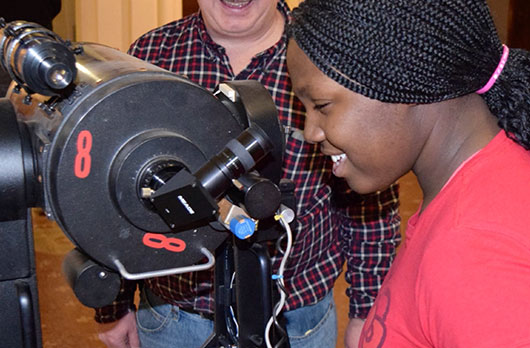
Funder:
National Science Foundation
Award Number:
1640131
Associated Universities Inc. (AUI)
Geneva Lake Astrophysics and STEAM, Inc.,
University of North Carolina (UNC) at Chapel Hill
University of Nevada Las Vegas (UNLV)
9/2016 – Present
Share This Page:
